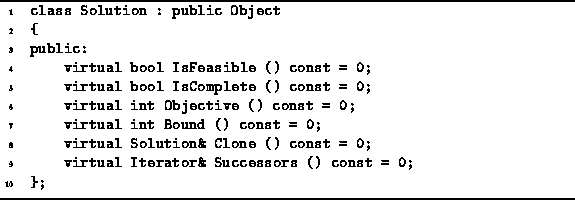 Data Structures and Algorithms
with Object-Oriented Design Patterns in C++
Data Structures and Algorithms
with Object-Oriented Design Patterns in C++





This section presents an abstract base class
for representing the nodes of a solution space.
By defining an abstract interface,
it is possible to hide the details of the specific problem to be solved
from the backtracking algorithm.
In so doing, it is possible to implement completely
generic backtracking problem solvers.
Although a backtracking algorithm behaves
as if it is traversing a solution tree,
it is important to realize that it is not necessary to have
the entire solution tree constructed at once.
Instead, the backtracking algorithm creates and destroys
the nodes dynamically as it explores the solution space.
Program  defines
the abstract class called Solution.
The Solution class is intended to serve as
the base class from which problem-specific classes are derived.
Each Solution instance represents a single node
in the solution space.
defines
the abstract class called Solution.
The Solution class is intended to serve as
the base class from which problem-specific classes are derived.
Each Solution instance represents a single node
in the solution space.

Program: Solution Class Definition
The Solution class is derived from the Object base class.
Consequently, instances of the Solution class can be inserted
in the various containers discussed in the preceding chapters.
The Solution class adds the following functions
to the inherited interface:
- IsFeasible
-
This function returns true if the solution instance is a
feasible solution to the given problem.
A solution is feasible if it satisfies the problem constraints.
- IsComplete
-
This function returns true if the solution instance
represents a complete solution.
A solution is complete when all possible decisions have been made.
- Objective
-
This function returns the value of the objective function
for the given solution instance.
- Bound
-
This function returns a value that is a lower bound (if it exists)
on the objective function for the given solution instance
as well as all the solutions
that can possibly be derived from that instance.
This is a hook provided for to facilitate the implementation
of branch-and-bound backtracking which is described
in Section
 .
.
- Clone
-
This function is used to clone the given solution instance.
It returns a reference to another, dynamically allocated
solution that is identical to the given solution instance.
- Successors
-
This function returns an iterator that enumerates
all of the successors (i.e., the children)
of the given solution instance.
It is assumed that this iterator creates the children of the given
node dynamically.





 Copyright © 1997 by Bruno R. Preiss, P.Eng. All rights reserved.
Copyright © 1997 by Bruno R. Preiss, P.Eng. All rights reserved.
![]() defines
the abstract class called Solution.
The Solution class is intended to serve as
the base class from which problem-specific classes are derived.
Each Solution instance represents a single node
in the solution space.
defines
the abstract class called Solution.
The Solution class is intended to serve as
the base class from which problem-specific classes are derived.
Each Solution instance represents a single node
in the solution space.
